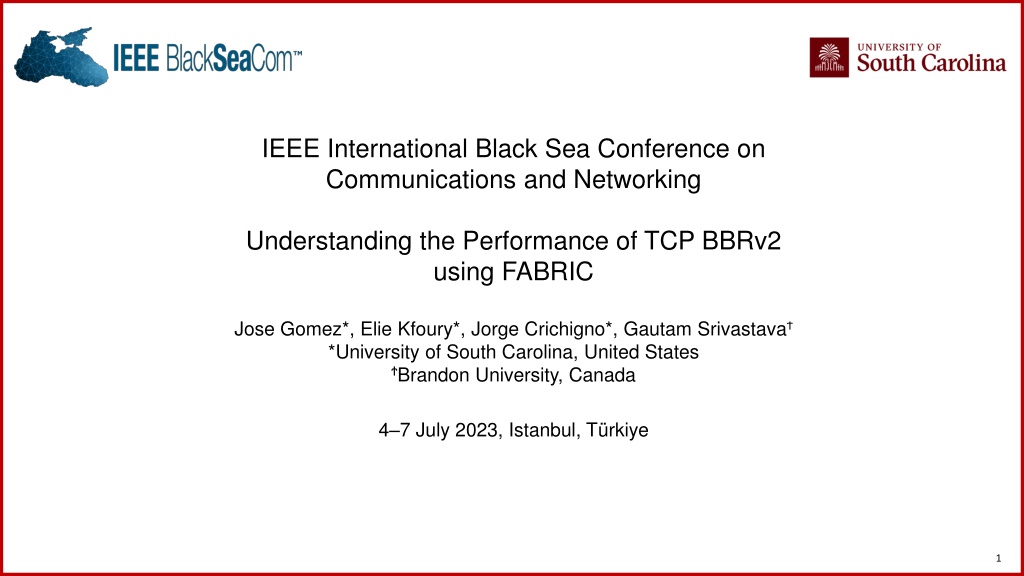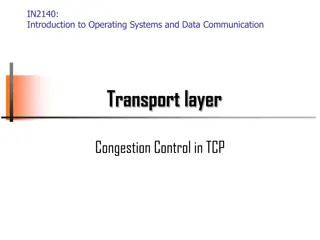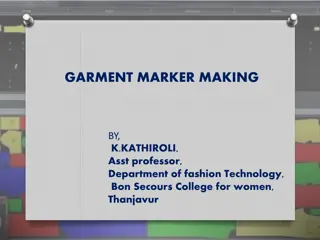Performance Analysis of TCP BBRv2 using FABRIC
IEEE International Black Sea Conference on Communications and Networking will feature a presentation on understanding the performance of TCP BBRv2 with FABRIC. The study compares traditional congestion control algorithms with BBRv2, highlighting its model-based approach and experimental results. Learn about BBRv2's unique features, including bottleneck bandwidth and RTT management, and its improvements over BBRv1. Explore how BBRv2 adapts to network conditions without always applying a multiplicative decrease for packet loss. Join the discussion at the conference for insights into modern congestion control strategies.
Uploaded on Mar 06, 2025 | 0 Views
Download Presentation

Please find below an Image/Link to download the presentation.
The content on the website is provided AS IS for your information and personal use only. It may not be sold, licensed, or shared on other websites without obtaining consent from the author.If you encounter any issues during the download, it is possible that the publisher has removed the file from their server.
You are allowed to download the files provided on this website for personal or commercial use, subject to the condition that they are used lawfully. All files are the property of their respective owners.
The content on the website is provided AS IS for your information and personal use only. It may not be sold, licensed, or shared on other websites without obtaining consent from the author.
E N D
Presentation Transcript
IEEE International Black Sea Conference on Communications and Networking Understanding the Performance of TCP BBRv2 using FABRIC Jose Gomez*, Elie Kfoury*, Jorge Crichigno*, Gautam Srivastava *University of South Carolina, United States Brandon University, Canada 4 7 July 2023, Istanbul, T rkiye 1
Agenda TCP Traditional Congestion Control Algorithms BBR: Model-based Congestion Control Motivation Experimental Setup Results and Evaluations Lessons Learned 2
TCP Traditional Congestion Control The principles of window-based congestion control (CC) were described in the 1980s1 Traditional CC algorithms follow the additive-increase multiplicative-decrease (AIMD) form of congestion control Packet loss Additive increase Multiplicative decrease Sending rate Time 1. V. Jacobson, M. Karels, Congestion avoidance and control, ACM SIGCOMM Computer Communication Review 18 (4) (1988). 3
TCP Traditional Congestion Control The principles of window-based congestion control (CC) were described in the 1980s1 Traditional CC algorithms follow the additive-increase multiplicative-decrease (AIMD) form of congestion control Packet loss Additive increase Multiplicative decrease Sending rate Time 1. V. Jacobson, M. Karels, Congestion avoidance and control, ACM SIGCOMM Computer Communication Review 18 (4) (1988). 4
BBR: Model-based Congestion Control TCP Bottleneck Bandwidth and RTT (BBR) is a rate-based CC algorithm1 BBR represented a disruption to the traditional CC algorithms: It is not governed by AIMD control law It does not the use packet loss as a signal of congestion At any time, a TCP connection has one slowest link bottleneck bandwidth (btlbw) probe Sending rate 125 Router Sender Receiver btlbw 100 75 drain Bottleneck (btlbw) Output port buffer Time cycle 1 cycle 2 ... 8 RTTs 1. N. Cardwell et al. "BBR v2, A Model-based Congestion Control." IETF 104, March 2019. 5
BBRv2 BBRv2 overcomes the shortcomings of BBRv1 BBRv2 measures the bandwidth, the RTT, the packet loss rate, and the ECN mark rate The measurements are used to estimate the bandwidth-delay product (BDP) BBRv2 does not always apply a multiplicative decrease for every round trip where packet loss occurs 6
Motivation Understanding the behavior of BBRv2 in a testbed with real propagation delay Observing the dynamics of BBRv2 in a Wide Area Network (WAN) Analyzing the differences between an emulated environment and a real testbed This work leverages the distributed architecture of the FABRIC testbed to reproduce WAN conditions and test the performance of BBRv2 (a) (b) CDF of the bottleneck bandwidth estimation of BBRv1 and BBRv2. (a) with 45ms emulated delay. (b) with 45ms propagation delay. 7
FABRIC FABRIC is an NSF-funded international infrastructure for at-scale experimentation and research Areas include networking, cyber, distributed computing, storage, 5G, ML, and others The FABRIC equipment is located at commercial collocation spaces, U.S. national labs, and campuses 29 FABRIC sites 8
Experimental Setup The experiments used a software switch to limit the rate and emulate packet losses The rate is limited using the Token Bucket Filter (TBF) in Linux Packet losses are emulated using NETEM The sites are selected based on the experiment 9
Results and Evaluations Experiment 1: Performance in a WAN with packet losses The rate is limited to 10Gbps The emulated packet loss rate is 0.0046% (i.e., 1/22,000) Performance of CUBIC, Reno, HTCP, BBRv1, and BBRv2 as a function of the RTT. (a) Throughput. (b) Retransmissions. Topology used for the evaluations 10
Results and Evaluations Experiment 2: Retransmissions as a function of the buffer size The RTT between the hosts is 45 milliseconds (SALT, FIU) BBRv2 presents lower packet loss rates than BBRv1 Performance test as a function of the BDP. (a) Throughput. (b) Retransmissions. 11
Results and Evaluations Experiment 3: RTT unfairness RTT unfairness occurs when flows with smaller RTTs obtain a higher throughput BBRv1 flows present the opposite behavior BBRv2 reduces the RTT unfairness of competing flows Topology used for running the RTT unfairness experiment Fairness index and throughput as functions of the buffer size for two competing flows. (a) BBRv1. (b) BBRv2. 12
Results and Evaluations Experiment 4: Parallel streams and different MTUs The rate is not limited (i.e., 100Gbps) The RTT between the sites is 26 milliseconds (DALL, SALT) BBRv1 and BBRv2 achieve throughputs over 70Gbps with eight streams Average throughput belonging to different CCAs as a function of the number of streams and the MTU. 13
Results and Evaluations Experiment 5: Throughput as a function of packet losses The performance of BBRv2 is close to that of BBRv1 for loss rates less than 1% (a) RTT = 26ms (DALL, SALT) (b) RTT = 57ms (UCSD, UMASS) 14
Results and Evaluations Experiment 6: Queue occupancy Link is limited to 10Gbps, the RTT is 50ms Bandwidth-delay Product = 10Gbps * 50ms = 62.5MB BBRv2 keeps the queue occupancy around BDP, even with bloated buffers 15
Limitations Configuration of the intermediary devices (e.g., routers and switches) Link capacity Router buffer size Queue allocation The experiments modified the buffer size of a software switch Shared Network Interface Cards (NICs) Performance isolation 16
Lessons Learned FABRIC can be used to test protocols and applications under WAN conditions The testbed can support a wide variety of experiments Its programmable infrastructure allows defining customized network environments BBRv2 provides improved fairness compared to BBRv1, particularly when dealing with flows that have different RTTs BBRv2 can achieve comparable throughput to BBRv1, while also exhibiting a lower retransmission rate 17























